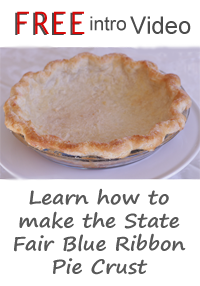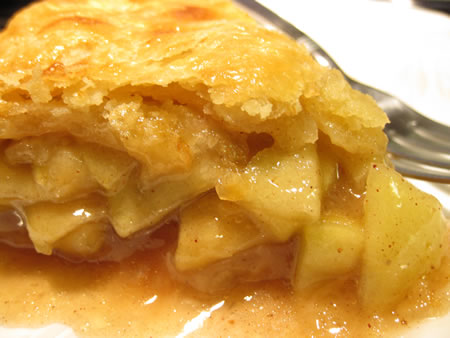Render Creamy Leaf Lard for Super Flaky Pie Crust
Posted by Pie Guy
Makes four pounds, leaf lard. Total prep 1 hr, 20
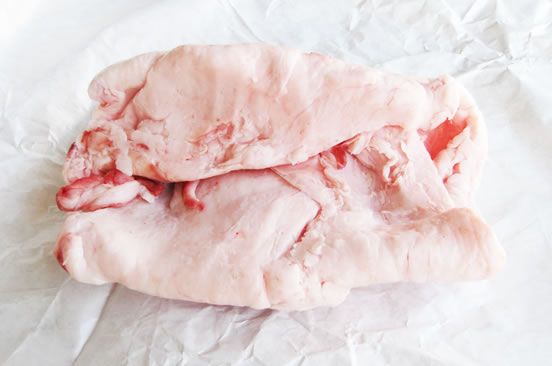
Render the lard myself. You’re joking?
Rendering leaf lard is simple. You need one heavy pot, a spoon for stirring, leaf lard from a pig and some time. Okay, a whole lot of time. That’s all folks.
What in the world is Leaf Lard?
Simply put, it is the original shortening, way before Crisco was invented. Leaf lard is the fat that surrounds the pig’s kidneys. It is superior in quality when rendered the right way and can make some of the best tasting and flakiest crust ever, at least it is what some say.
One big problem about Leaf Lard
Most of you will not be able to find it at your local grocery store.
Great! So now what do you do?
You have two choices? Render it yourself (this is what I did) or order it online.
Where do I get the lard?
Go to your local meat butcher where they receive whole pigs.
No silly, do not ask those guys in white strait-jackets that shrink wrap everything. You need to see a real butcher, one who is trained to slaughter a fresh killed hog.
Say these exact words, "Can you provide me with leaf lard?" If the answer is, what is leaf lard, then you are talking to the wrong fellow.
Fantastic! You found some leaf lard
Maybe like me, you had to drive an hour to pick it up. I called four shops before getting to someone who knew what leaf lard was and how to get it from the pig.
Fine leaf lard will not add a porky flavor to your pie crust. If you were to taste it straight, it has a smooth texture with a creamy milk shake like flavor that coats your tongue. Did not MacDonald’s use lard in their ice cream?
Okay, let’s render the Leaf Lard for pie crusts and pastries.
Here’s a short video of the rendering of my leaf lard.
—How-to Render Creamy Leaf Lard for Super Flaky Pie Crust—
What you need
A large heavy pot
One large Spoon (wood or metal)
5 pounds of Leaf Lard (cleaned)
Directions for rendering Lard
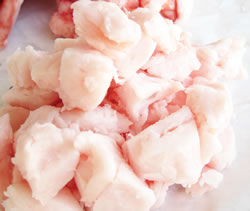
1. Prepare the lard
Clean the fat of any pieces of meat or skin. You want just the fat, the pale looking stuff.
If you leave pieces of meat or organs on the fat, it will taint the flavor of your rendered lard, please no pork taste.
Dice and cut up the fat in small pieces, about 1/2-inch cubes.
2. Put your diced fat into a large heavy pot. Start with a cool pot and place it on medium-low heat. We should not hear much sizzling at this stage. For creamy lard, cook it slow and low.
To prevent the house smelling like fried bacon, I rendered the leaf lard outside on a gas burner. Do it on a sunny day, relax and take in the sunshine.
3. Stir frequently so that the pieces at the bottom move to the top.
Use a wooden or metal spoon.
All others will melt.
We are trying to prevent any caramelization from the heat, keep the mixture pale in color. If it starts to brown, reduce the heat.
There should be no burning or smoke smells coming from the pot.
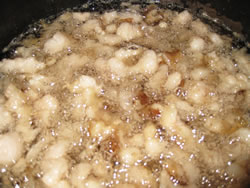
4. In about 35 – 50 minutes, some of the fat will start to float in the pot. It is now time to pour off the rendered fat for pies.
It will be pure white and have no porky taste when cooled, supreme leaf lard.
Use a stainless steel bowl to hold the hot liquid.
Let it cool a little so it is no longer hot but still warm.
Are you a perfectionist? then Do not allow your lard to get above 255 F.
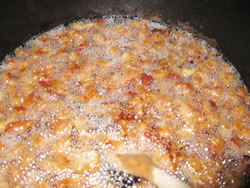
5. Now return the pot to the heat and cook until you get cracklings, crunchy bits of fat. Still keep the heat low.
This lard will be good for your pot pies and savory pie crust recipes. There will be a slight hint of a smoky porky flavor to this lard.
Store the hot liquid fat in a stainless steel bowl to let it cool some.
This process takes about 20 – 30 minutes more.
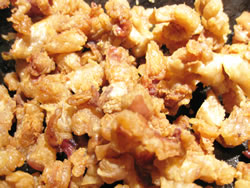
Save your cracklings. They are yummy to eat with a bit of salt or use on salads like bacon bits.
Now let’s prepare the lard for storage
6. Pour the warm mixture through some cheese cloth. Please be careful. You want to filter out the solids. The best way is to line a strainer with the cheese cloth, and pour through it.
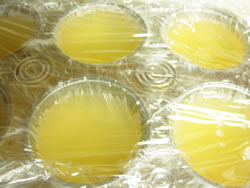
7. Prepare a muffin pan by loosely placing plastic wrap over the cavities. Push the plastic in each cavity so it stays in the forms.
8. Place a half-cup of the warm leaf lard mixture into each cavity. Place another sheet of plastic on top and place it in the refrigerator. Be sure to keep it level.
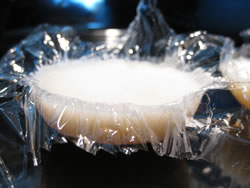
9. Chill until the rendered leaf lard is white and hard. This takes about two hours.
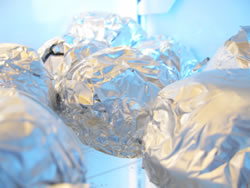
10. Remove the round lard packs from the muffin pan and wrap with foil – leave on the plastic wrap.
You can save it for months in the freezer.
Just take out what you need for your pies.
Be sure to label the lard packs for sweet or savory pies.
Rendered Lard Tip – saving some for later
Frozen lard lasts for more than a year if sealed air tight.
The number one Pie Crust Recipe uses Lard and Butter
